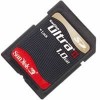SanDisk SDSDH-1024 Product Manual - Page 92
Bus Transfer Protection, Data Read
 |
UPC - 710348911073
View all SanDisk SDSDH-1024 manuals
Add to My Manuals
Save this manual to your list of manuals |
Page 92 highlights
Revision 2.2 Chapter 5 - SPI Protocol SD Card Product Manual 5.3 Bus Transfer Protection CRC bits protect every SD Card token transferred on the bus. In SPI mode, the SD Card offers a non protected mode which enables systems built with reliable data links to exclude the hardware or firmware required for implementing the CRC generation and verification functions. In the non-protected mode the CRC bits of the command, response and data tokens are still required in the tokens however, they are defined as "don't care" for the transmitters and ignored by the receivers. The SPI interface is initialized in the non-protected mode. The host can turn this option on and off using CRC_ON_OFF command (CMD59). The CRC7/CRC16 polynomials are identical to that used in SD Bus mode. Refer to this section in the SD Bus mode chapter. 5.4 Data Read SPI mode supports single block and multiple-block read operations (SD Card CMD17 or CMD18). Upon reception of a valid read command the card will respond with a response token followed by a data token in the length defined in a previous SET_BLOCK_LENGTH (CMD16) command (see Figure 5-1). Figure 5-1 Single Block Read Operation From Host to Card DataIn Command From Card to Host Next Command Data from Card to Host Com mand DataOut Response Data Block CRC A valid data block is suffixed with a 16-bit CRC generated by the standard CCITT polynomial: x16+x12+x5+1. The maximum block length is 512 bytes as defined by READ_BL_LEN (CSD parameter). Block lengths can be any number between 1 and READ_BL_LEN. The start address can be any byte address in the valid address range of the card. Every block, however, must be contained in a single physical card sector. In case of data retrieval error, the card will not transmit any data. Instead, a special data error token will be sent to the host. Figure 5-2 shows a data read operation, which terminated with an error token rather than a data block. © 2004 SanDisk Corporation 5-2 12/08/04















